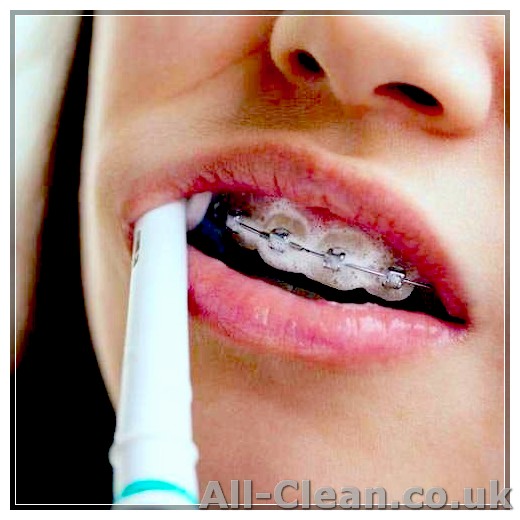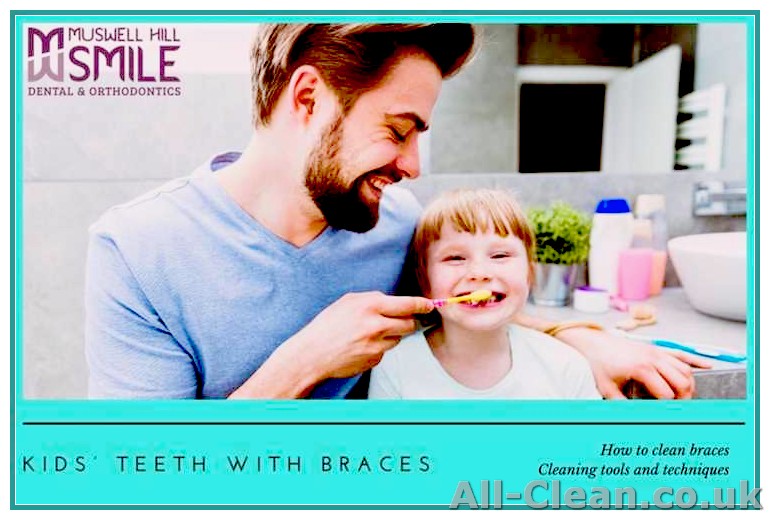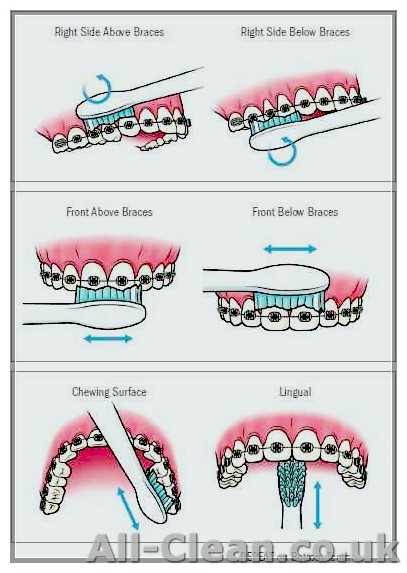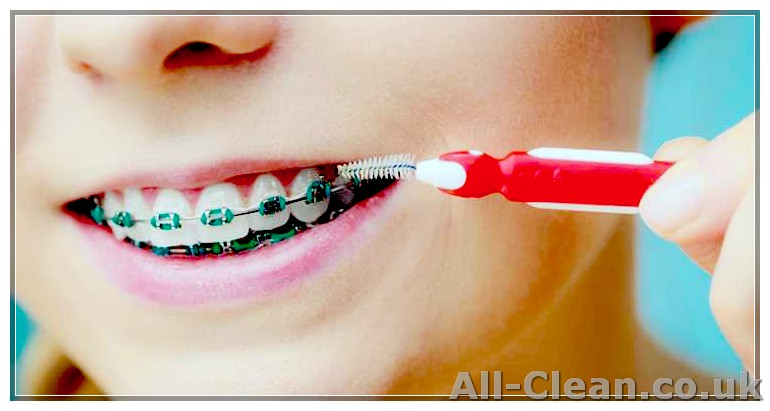
If you have braces, it’s important to regularly clean your teeth to keep them healthy and free from debris. Your dentist will likely give you a special cleaning guide and tools to help you with the process. One key takeaway is that brushing your teeth with braces may take a bit more time and effort than it did before, but it is vital for maintaining good oral hygiene.
When brushing your teeth with braces, it’s important to brush both the outer and inner surfaces of your teeth. Start by carefully removing any food particles or debris that may be stuck around the braces. Use a toothpaste with fluoride to help kill bacteria and strengthen your tooth enamel. Brush your teeth gently, but thoroughly, making sure to clean each tooth and brace, as well as the gum line.
In addition to brushing, flossing is also crucial for keeping your teeth and braces clean. Your dentist may have recommended a special floss designed for braces. Use this floss to carefully clean between each tooth and around the braces. Make sure to reach the areas where the braces meet your teeth to remove any plaque or food particles that may have accumulated.
It’s important to visit your dentist regularly for check-ups and cleanings. Your dentist will be able to guide you on the best brushing and flossing techniques for your specific braces. They can also answer any questions you may have and address any concerns you may be experiencing. Regular dental visits ensure that your teeth and braces are in good condition and that your overall oral health is being maintained.
By following these top tips, you can ensure that your teeth stay clean and healthy while you have braces. Regularly cleaning your teeth, both in the morning and at night, will keep plaque and bacteria at bay. Don’t forget to continue your regular check-up appointments with your dentist and ask them any questions you may have along the way. With proper care and hygiene, you can keep your smile bright, even with braces.
- Frequently Asked Questions
- How often should I brush my teeth with braces?
- What toothbrush should I use?
- How should I brush my teeth with braces?
- Should I use toothpaste when brushing with braces?
- Can I floss with braces?
- How often should I have my teeth cleaned with braces?
- What tools can help me clean my teeth with braces?
- Can I eat and drink anything with braces?
- What should I do if a wire or bracket comes loose?
- When can I remove my braces or aligners?
- How can I keep my teeth white with braces?
- Can I continue playing sports or musical instruments with braces?
- What should I do if I have any other questions or concerns?
- How Do Dentists Clean Your Teeth With Braces
- 1. Examining your teeth and braces
- 2. Using fluoride in the cleaning process
- 3. Brushing with special tools
- 4. Flossing with a threader
- 5. Checking for any missed spots
- 6. Providing recommendations and answering questions
- How Often To Visit The Dentist With Braces
- Regular Check-ups
- Special Dental Cleanings
- Questions to Ask
- Full Treatment Duration
- The Takeaway
- Dental Care Should Continue At Home
- Brushing and flossing
- Use special cleaning tools
- Regular dental visits
- Key takeaways:
- What A Routine Dental Cleaning Entails
- What to Expect
- At-Home Care
- Conclusion
- Key Takeaways
- Brushing the Outer Side of Your Teeth
Frequently Asked Questions
How often should I brush my teeth with braces?
It is recommended to brush your teeth with braces at least twice a day, in the morning and before bed.
What toothbrush should I use?
Use a soft-bristled toothbrush with a small head that can easily reach all areas of your teeth and braces.
How should I brush my teeth with braces?
Start by rinsing your mouth with water to loosen any food particles. Then, carefully brush the outer and inner surfaces of your teeth and braces. Use circular motions and gentle pressure to clean the braces. Don’t forget to brush the tops of your teeth and the back of your mouth as well.
Should I use toothpaste when brushing with braces?
Yes, use fluoride toothpaste to help prevent cavities and keep your teeth and braces clean.
Can I floss with braces?
Yes, you can and should floss with braces. Use a floss threader or a special orthodontic floss to get between the wires and clean the spaces between your teeth.
How often should I have my teeth cleaned with braces?
You should continue to have regular cleanings with your dentist every six months. These cleanings will help remove any plaque or tartar buildup that you might not be able to reach with your toothbrush.
What tools can help me clean my teeth with braces?
There are some tools that can make cleaning your teeth with braces easier, such as interdental brushes, water flossers, or mouthwash. These can help clean hard-to-reach areas and remove food particles.
Can I eat and drink anything with braces?
While wearing braces, it’s best to avoid hard, sticky, or chewy foods that can damage the braces or get stuck. Also, try to limit your intake of sugary foods and drinks that can cause decay.
What should I do if a wire or bracket comes loose?
If a wire or bracket comes loose, contact your orthodontist as soon as possible to schedule a repair. In the meantime, you can use orthodontic wax to cover the sharp edges and prevent irritation.
When can I remove my braces or aligners?
The length of time you need to wear braces or aligners depends on the correction needed. Your orthodontist will let you know when it’s time to remove them and transition to a retainer to maintain the alignment.
How can I keep my teeth white with braces?
While wearing braces, it’s important to maintain good oral hygiene to prevent stains and keep your teeth white. Brush and floss regularly, limit your intake of staining foods and drinks, and consider using whitening toothpaste or mouthwash.
Can I continue playing sports or musical instruments with braces?
Yes, you can continue with your regular activities, but it’s important to wear a mouthguard during sports and be cautious with your braces when playing musical instruments. Consult with your orthodontist for specific recommendations.
What should I do if I have any other questions or concerns?
If you have any other questions or concerns about caring for your teeth with braces, don’t hesitate to ask your orthodontist. They are there to guide you and provide support throughout your orthodontic treatment journey.
How Do Dentists Clean Your Teeth With Braces
When you have braces, it’s important to take proper care of your teeth and follow the correct steps for cleaning. Regular dental visits are an essential part of maintaining a healthy smile, and your dentist or hygienist plays a crucial role in helping you keep your teeth clean. Here is a top guide on how dentists clean your teeth with braces:
1. Examining your teeth and braces
Before starting the cleaning process, the dentist or hygienist will examine your teeth and braces to identify any areas that need special attention. They may use a small mirror to get a better view and check for any signs of plaque or other issues.
2. Using fluoride in the cleaning process
Fluoride is often used during the cleaning process to provide additional protection for your teeth. It helps strengthen the enamel and prevent tooth decay. The dentist or hygienist may apply fluoride gel or foam to your teeth and allow it to sit for a few minutes before rinsing it off.
3. Brushing with special tools
The dentist or hygienist will use special brushes and tools to clean your teeth and braces. They will carefully brush the areas around the brackets and wires to remove any plaque or food particles that may be stuck. It’s important to brush gently but thoroughly to ensure all the surfaces are clean.
4. Flossing with a threader

Flossing can be more challenging with braces, but it’s still an essential part of oral hygiene. The dentist or hygienist may use a threader to help guide the floss between the wires and brackets. They will show you how to do it properly so you can continue flossing at home.
5. Checking for any missed spots
After brushing and flossing, the dentist or hygienist will check for any missed spots or areas that need further attention. They may use a special dye or light to detect any plaque or buildup that may be hiding from sight. This ensures a thorough cleaning and prevents any potential issues.
6. Providing recommendations and answering questions
The dentist or hygienist will provide recommendations on proper oral care and answer any questions you may have. They may suggest specific toothpaste or tools to use, and demonstrate the best techniques for cleaning your teeth with braces. They’ll also advise on how often you should book dental check-ups to maintain good oral health.
Remember, regular dental visits and proper at-home care are crucial for achieving the best results with your braces. Following the steps and recommendations from your dentist or hygienist will help keep your teeth and braces clean, free from bacteria and debris, and ensure a healthy smile!
How Often To Visit The Dentist With Braces
When you have braces, it’s important to visit your dentist regularly to ensure that your teeth and gums stay healthy throughout your treatment. Your dentist can provide guidance and professional cleanings to keep your smile in top shape. Here’s a guide on how often you should visit the dentist while wearing braces.
Regular Check-ups
It’s recommended to visit the dentist every six months for routine check-ups and cleanings. During these visits, your dentist will assess the health of your teeth and gums, and remove any plaque or tartar buildup. They will also check the progress of your orthodontic treatment and make any necessary adjustments to your braces.
Special Dental Cleanings
In addition to your regular check-ups, your dentist may recommend special cleanings designed specifically for patients with braces. These deep cleanings, known as scaling and root planing, target the areas around the brackets and wires where plaque and bacteria can accumulate. They help keep your braces clean and prevent gum disease.
Questions to Ask
When you visit your dentist with braces, don’t hesitate to ask questions about your oral care routine. They can provide tips and recommendations on how to properly brush and floss with braces, as well as suggest the best tools to use. You can also inquire about the use of fluoride mouthwash to strengthen your enamel and keep your teeth cavity-free.
Full Treatment Duration
The duration of your orthodontic treatment will determine how long you need to visit the dentist regularly. If your treatment is expected to last two years, for example, you will need to continue booking dental appointments throughout that time. Your dentist will let you know how often you should return for check-ups and cleanings.
The Takeaway

Visiting the dentist regularly is important for patients with braces. Regular check-ups and special cleanings help ensure that your teeth and gums stay healthy throughout the treatment process. By following your dentist’s instructions and maintaining a proper oral care routine, you can achieve the best possible results from your braces or aligners.
Dental Care Should Continue At Home

Even if you’re wearing braces, dental care should not stop when you leave the dentist’s office. In fact, it’s even more important to take care of your teeth and gums at home to ensure the best results from your orthodontic treatment.
When you have braces, it’s easy for food particles to get stuck in the brackets and wires. If not cleaned properly, this can lead to plaque buildup, tooth decay, and gum disease. That’s why it’s crucial to continue your dental care routine and follow these key steps:
Brushing and flossing

Brush your teeth at least two times a day with a soft-bristle toothbrush. Use a toothpaste with fluoride to help protect your enamel. Remember to brush along the gum line and in between brackets and wires. Be gentle to avoid damaging your orthodontic appliances.
Flossing is also important, but it can be challenging with braces. Using a floss threader can make the process easier. Thread the floss through the threader, then carefully guide it under the wire and between your teeth. Move the floss up and down to clean the sides of each tooth. Regular flossing will help remove plaque and food particles from hard-to-reach areas.
Use special cleaning tools
Orthodontic brushes and interdental brushes can be useful for cleaning around brackets and wires. These small brushes can reach areas that a regular toothbrush may miss. Look for brushes designed specifically for braces and ask your dentist or orthodontist for recommendations.
Mouthwash can also be included in your dental care routine. An antiseptic mouthwash can kill bacteria and freshen your breath. Swish it around in your mouth for the recommended time, then spit it out. Be sure to choose an alcohol-free mouthwash to avoid drying out your mouth.
Regular dental visits
Continue to visit your dentist or orthodontist regularly for cleanings and check-ups. These professionals will be able to clean areas that you might miss at-home, and they can also address any questions or concerns you may have. Dental visits are crucial for keeping your teeth and gums healthy while undergoing orthodontic treatment.
Remember, having braces doesn’t mean you have to sacrifice a healthy smile. With proper at-home dental care and regular visits to the dentist, you can help maintain good oral hygiene and ensure the best results from your orthodontic treatment.
Key takeaways:
- Continue your dental care routine at home while wearing braces.
- Brush your teeth at least twice a day with a fluoride toothpaste.
- Use a floss threader to floss between brackets and wires.
- Consider using special cleaning tools like orthodontic brushes and interdental brushes.
- Include mouthwash in your dental care routine, choosing an alcohol-free option.
- Regularly visit your dentist or orthodontist for cleanings and check-ups.
What A Routine Dental Cleaning Entails
Regular dental cleanings are an essential part of maintaining good oral health, especially when you have braces. These cleanings help remove plaque, tartar, and other buildup that can accumulate around your brackets and wires. They also allow your dentist to monitor the health of your teeth and gums, ensuring that your orthodontic treatment is on track.
What to Expect
When you book a routine dental cleaning, you’ll typically be asked to arrive a few minutes early to fill out any necessary paperwork. Once you’re in the dental chair, the cleaning process can begin.
The first step in a dental cleaning is brushing. Your dentist or dental hygienist will use a high-powered electric toothbrush to thoroughly clean your teeth and remove any surface stains. They’ll pay special attention to your brackets and wires, making sure to clean around and between them.
After brushing, your dentist or dental hygienist will use dental floss to remove any debris that may be stuck between your teeth and braces. This helps to ensure that your teeth are clean and free from bacteria and plaque.
Next, your dentist or dental hygienist may use a scaler to remove any remaining buildup on your teeth. They’ll carefully scrape away any tartar or plaque that has accumulated, paying close attention to the areas around your brackets and wires.
Once your teeth are clean and free of debris, your dentist or dental hygienist may apply a fluoride treatment. Fluoride helps to protect your teeth from cavities and strengthens your tooth enamel. They may use a fluoride gel, rinse, or varnish, depending on their preference.
At-Home Care
While routine dental cleanings are important, it’s also crucial to maintain good oral hygiene at home. Brushing your teeth at least twice a day with a fluoride toothpaste and flossing between your teeth and around your braces should be part of your daily routine. If you have any questions about proper brushing or flossing technique, don’t hesitate to ask your dentist or dental hygienist.
In addition to brushing and flossing, it’s important to continue your orthodontic care at home. Follow the instructions given to you by your orthodontist, and make sure to avoid any foods or habits that could damage your braces. Regularly visit your orthodontist for adjustments and check-ups to ensure your treatment is progressing well.
Conclusion
A routine dental cleaning is a comprehensive process that helps keep your teeth and gums healthy while you have braces. The steps involved in cleaning your teeth with braces are similar to a regular dental cleaning, but with extra attention given to your brackets and wires. By following a proper oral hygiene routine and regularly visiting your dentist and orthodontist, you can ensure that your orthodontic treatment will be successful and lead to a healthy and beautiful smile.
Key Takeaways
- Brush your teeth carefully and more often when you have braces. Make sure to brush between the wires and around the brackets to remove any food debris.
- Use a soft-bristled toothbrush and fluoride toothpaste to clean your teeth properly. Brush in a circular motion and pay extra attention to the areas around the brackets.
- Flossing is essential for keeping your teeth and gums healthy. Use a floss threader or orthodontic floss to carefully clean between your teeth and braces.
- Regular visits to the dentist are crucial during orthodontic treatment. Book dental cleanings every six months or as recommended by your dentist.
- Proper technique and routine are key to maintaining good oral hygiene with braces. Take the time to learn how to brush and floss correctly and continue this routine even after your braces are removed.
- If you have aligners, make sure to remove them before brushing and flossing. Clean your aligners separately and place them back in after cleaning your teeth.
- Don’t forget to follow any additional instructions given by your orthodontist or dentist. They may recommend using special tools or mouth rinses to further enhance your oral hygiene.
- Avoid hard and sticky foods that could easily get stuck in your braces. Cut tough foods into smaller pieces and chew carefully to prevent damage to your braces.
Brushing the Outer Side of Your Teeth
One of the key steps in maintaining good oral hygiene while wearing braces is brushing the outer side of your teeth. This is where plaque and bacteria tend to accumulate, so it’s important to clean this area thoroughly.
Here are some tips to help you brush the outer side of your teeth effectively:
- Use a toothbrush designed for braces: An orthodontic toothbrush has bristles that are specifically designed to clean around the brackets and wires of your braces. It can reach the areas that a typical toothbrush might miss.
- Brushing technique: Hold your toothbrush at a 45-degree angle to your teeth and brush in small circular motions. Be sure to clean the surface of each tooth, paying special attention to the brackets and wires.
- Brush from the top down: Start brushing from the top of your mouth and work your way down. This will ensure that you clean all the surfaces of your teeth.
- Don’t forget the gaps: Pay attention to the gaps between your teeth and the braces. These areas can easily trap food particles and bacteria. Use a orthodontic floss or a floss threader to clean between the brackets and wires.
- Use fluoride toothpaste: Choose a toothpaste that contains fluoride to help protect your teeth from cavities. Fluoride is especially important when wearing braces, as it helps strengthen the enamel.
- Brush at least twice a day: Brushing your teeth at least twice a day will help remove plaque and bacteria, keeping your mouth clean and healthy. If possible, brush after every meal to remove any food particles that may have gotten stuck in your braces.
- Use mouthwash: Incorporating mouthwash into your oral hygiene routine can help kill bacteria and freshen your breath. Look for a mouthwash that is specifically designed for use with braces.
Remember, it’s important to maintain regular cleanings with your dentist while wearing braces. They can remove any plaque or tartar buildup that may be harder for you to reach at home. Your dentist may also recommend additional steps to keep your teeth and braces clean and healthy.
By following these tips for brushing the outer side of your teeth, you’ll be able to keep your braces clean and your teeth healthy. This will help ensure that your orthodontic treatment progresses smoothly and that you achieve the best possible results.
Takeaways:
- Brush the outer side of your teeth thoroughly to remove plaque and bacteria.
- Use a toothbrush designed for braces and brush in small circular motions.
- Pay attention to the gaps between your teeth and the braces.
- Brush at least twice a day and use fluoride toothpaste.
- Incorporate mouthwash into your routine to kill bacteria and freshen your breath.
- Regular cleanings with your dentist are essential.








